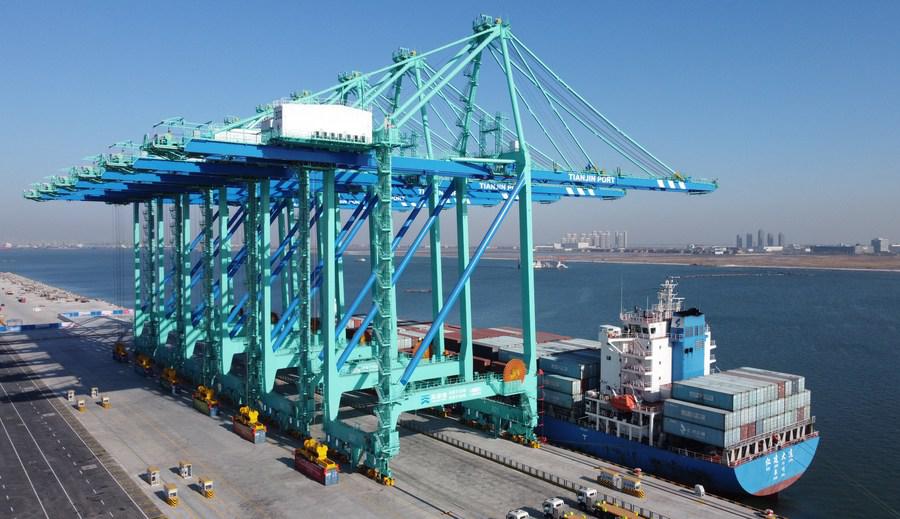Ancient port charts new course towards green, smart hub serving Belt and Road
-- During his visit to Tianjin Port in early 2019, Chinese President Xi Jinping called for efforts to develop it into a world-class smart and green port, which can better serve the coordinated development of the Beijing-Tianjin-Hebei region as well as the joint building of the Belt and Road.
-- Despite the pandemic-induced impacts, Tianjin Port handled 18.35 million Twenty-foot Equivalent Units (TEUs) in 2020, up 6.1 percent from the previous year, ranking among the top 10 in the world.
-- Located at the coastal area of Bohai, China's continental sea, Tianjin Port has a shorter distance from the country's inland ports, such as Alataw Pass in Xinjiang Uygur Autonomous Region and Manzhouli and Erenhot in Inner Mongolia Autonomous Region -- all important border ports along the Belt and Road. Therefore, sea-railway combined transportation has become a preferred choice that serves the Belt and Road.
TIANJIN, May 30 (Xinhua) -- Under the scorching sun, a dockside crane in Tianjin Port lifted a container out of a vessel before the container was locked onto a tow truck and carried away.
The entire process was going on in a manless operation zone at the port in north China's Tianjin Municipality, which aims to become a smart, green hub connecting the world via the Belt and Road Initiative.
With 25 autonomous driving trucks and the driverless dockside and terminal cranes put into operation last year, the berth realized full automation in container handling after being upgraded from a traditional one, the first of its kind in the world.

Photo taken on Jan. 17, 2021 shows an autonomous driving container truck in a manless operation zone at Tianjin Port of north China's Tianjin Municipality. (Xinhua/Zhao Zishuo)
During his visit to Tianjin Port in early 2019, Chinese President Xi Jinping called for efforts to develop it into a world-class smart and green port, which can better serve the coordinated development of the Beijing-Tianjin-Hebei region as well as the joint building of the Belt and Road.
Currently, the port has trade ties with more than 800 ports in over 200 countries and regions.
Despite the pandemic-induced impacts, Tianjin Port handled 18.35 million Twenty-foot Equivalent Units (TEUs) in 2020, up 6.1 percent from the previous year, ranking among the top 10 in the world. The freight turnover increased 2.4 percent year on year to over 435 million tonnes.
SMART MODEL
Liu Qi, a crane operator, no longer has to stay in the high-lift crane operating booth working 12 hours per shift. Thanks to the smart technology supported by China's Beidou Navigation Satellite System, he can now sit in the air-conditioned office and steer the joystick to remotely control the crane.
"Gone are the days when I could barely move after leaning down for long hours to watch over the containers," said the 46-year-old Liu, as he focused on the six monitor screens in front of him. The screens enable him to have no blind spots in observation, which is much safer than before.
Li Dan, 35, is among the first women hired for remote crane control. Li used to sort cargo at the port before she was trained for six months on cranes and operated them in the operation control room. Her salary then tripled to some 6,000 yuan (about 940 U.S. dollars) a month.
"I was afraid of climbing up the 50-meter-tall crane at the beginning. It used to wobble in windy and stormy weathers," she said, adding that she had to hold herself from going to a toilet while in a crane booth. "No wonder we had no female crane drivers before."
Now, each of the operators can control six terminal container cranes simultaneously.
Partly because of the improved handling efficiency, 90 percent of the incoming vessels can directly dock at the 192 berths of the port upon arrival, without any waiting time, said Chu Bin, chairman of the board of the Tianjin Port (Group) Co., Ltd. (TPG).
A newly-built smart port zone with three berths, located close by the manless operation zone of the port, will soon be put into use. With 12 driverless dockside cranes of different colors and 76 autonomous driving trucks equipped, the 5G-empowered berths have a designed handling capacity of 2.5 million TEUs every year.
Chu said that the new port zone will save energy by 20 percent and cut operating costs by 25 percent. "The rainbow-colored port zone will become a new beautiful scenery."

Photo taken on Jan. 17, 2021 shows a smart container terminal at Tianjin Port in north China's Tianjin Municipality. (Xinhua/Zhao Zishuo)
OLD PORT, NEW AMBITION
The sea transportation of Tianjin Port dates back more than 1,000 years to the Tang Dynasty (618-907), when grains were shipped via the port to the northern border army.
After the founding of the People's Republic of China in 1949, the war-torn port was rebuilt and reopened in 1952.
Back then, workers had to shoulder cargoes to load them on and off the vessels. Cheng Jingang, a former port loader, said that carrying brown sugar packs was the toughest work in winter.
"The imported sugar was stiff in freezing weather, and countless trips carrying them often left our shoulders swollen," the 71-year-old retiree recalled.
Cheng is delighted to see that his son, Cheng Weidong, did not have to go through similar misery while working. The junior Cheng, 42, is a tow truck driver at the port. Instead of simply driving, he also participates in the research and development to convert fuel trucks into electric ones as part of the port's green drive.
"I have learned the CAD software for design and drafting, and the 3D printing also helps a lot," said the younger Cheng.
To help cut carbon emissions, trains have replaced trucks to deliver large volumes of cargo to the port, including 100 percent of coal and coke.
As a result, the number of trucks that come and go has reduced from 50,000 to 30,000 per day, which helps cut carbon emissions equivalent to those of 4 million cars, said Chu, the chairman.
Thanks to the measures, pollutant emissions were cut by more than 3,000 tonnes last year.
The port is also promoting clean energy, with rooftop solar panels and wind windmills to be installed.
"By making use of wind and solar energy, we will strive to realize zero carbon emission in our port," said Chu.
GLOBAL HUB
Liu Yu, deputy publicity manager of the TPG, said the port could only harbor a 10,000-tonne vessel in the 1950s, and now, handling a 300,000-tonne ship is a piece of cake.
Located at the coastal area of Bohai, China's continental sea, Tianjin Port has a shorter distance from the country's inland ports, such as Alataw Pass in Xinjiang Uygur Autonomous Region and Manzhouli and Erenhot in Inner Mongolia Autonomous Region -- all important border ports along the Belt and Road.
Therefore, sea-railway combined transportation has become a preferred choice that serves the Belt and Road.

Aerial photo taken on Jan. 11, 2021 shows a view of the Pacific international container terminal at Tianjin Port in north China's Tianjin Municipality. (Xinhua/Zhao Zishuo)
Wu Da, deputy manager of Tianjin China-Railway United International Container Co., Ltd., said China-Europe freight trains now operate twice a week from and to Tianjin Port, with more than 10,000 containers delivered a year.
"The sea-railway transportation of Tianjin Port has ensured the import and export of cargo between China and multiple cities in East, Central and West Asia, and Europe during the pandemic, contributing to the foreign trade and supply chain stability," he said.
The total TEU number delivered by trains through the port surged from about 100,000 in 2015 to 805,000 last year. To meet the rising demand, Wu's company has planned to extend the railway line directly to the port and expand the cargo terminal.
The number of container ship routes connecting Tianjin Port and the countries along the 21st Century Maritime Silk Road has increased from over 30 in 2019 to about 50 now, and more than 60 percent of the port's total cargo turnover comes from ports of these countries.
The port is also a pivotal shipping outlet in the Beijing-Tianjin-Hebei area.
Since 2014, when China initiated a key strategy to coordinate the development of Beijing, Tianjin and Hebei, Tianjin Port and neighboring ports in Hebei Province have cooperated to make themselves a world-class port cluster.

Aerial photo shows a container vessel sailing into Tianjin Port in north China's Tianjin Municipality, Feb. 22, 2021. (Xinhua/Zhao Zishuo)
Leaving Tianjin Port, a vessel carrying timber imported from Germany, wheat from Russia and paper pulp from the United States headed to the Caofeidian Port in the coastal city of Tangshan, Hebei Province.
Wu Zhiming, general manager of a timber trade company based in Nanjing, Jiangsu Province, said his company used to hire trucks to deliver timber to Tangshan after the Germany-made spruce timber was shipped to Tianjin.
"The branch sea route within the Bohai Sea has saved us 20 percent of logistic costs, with more reliable arrival time," said Wu, adding that they will have more cargo shipped via the route.
Tianjin Port serves the megacities of Beijing and Tianjin, as well as the emerging Xiong'an New Area in Hebei.
"The port not only serves the foreign trade and production, but also helps with consumption to cater to people's pursuit of better lives," said Chu, TPG chairman of the board.
Cheng Zeming, the son of truck driver Cheng Weidong, is fascinated with the new autonomous driving container cranes at Tianjin Port. The 11-year-old said when he grows up, he would like to work in the port just like his father and grandfather.
"With cutting-edge 5G and AI technologies, I can't imagine what the port will be like when my son starts to work," said Cheng Weidong.
Photos
Related Stories
- China releases Analects of Confucius versions for Belt and Road countries
- China's patent grants, applications grow in B&R countries
- China vows belt of cooperation, development with Central Asia
- Int'l community casts vote of confidence in Belt and Road
- Chinese FM puts forward proposals for high-quality Belt and Road development
Copyright © 2021 People's Daily Online. All Rights Reserved.










